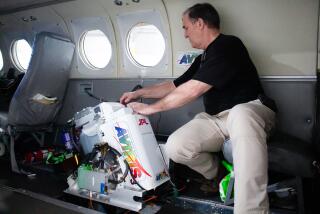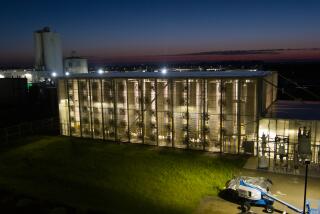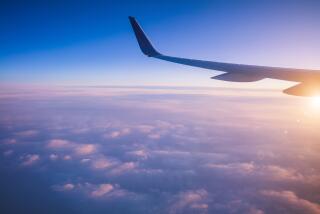ANTARCTICA : THE HOLE BELOW ZERO
- Share via
SANTA BARBARA — Sometime in the next two months, word will come from 13 scientists in Antarctica about the condition of this planet’s torn sky. Human beings everywhere will--or should--listen with attention. The voices that come floating up from the bottom of the Earth will be using words like ozone and chlorofluorocarbons and stratosphere, but they will be talking about human survival.
If this were fiction, the 13 would be astronomers tracking the collision course of a comet. But this is real life, as always more subtle than adventure novelists might prefer. The 13 are chemists and physicists and they went to Antarctica late this month to study a part of the atmosphere called the ozone layer. The occasion is stirring enough and this is a pilgrimage. There is symmetry and solemnity to this dramatic National Ozone Expedition, already known as NOZE at the National Science Foundation. The men and women who flew south on an extraordinary flight to the United States base at McMurdo Sound went to the continent that has become the world’s first global community, in search of clues to what may be humankind’s first true global disaster.
Some of the clues have already been identified; they lent urgency to this emergency expedition. In the 1970s scientists suggested that chlorofluorocarbons, more simply known as CFCs, were starting to eat away the ozone layer in the stratosphere. CFCs have been used, among other things, to blast aerosol spray out of the can. Ozone, which is three linked atoms of oxygen (regular oxygen is two), screens out much of the sun’s ultraviolet radiation; if it is depleted, life on earth could be broadly damaged. Skin cancer would proliferate, crop yields could diminish, the ocean’s food chains could suffer and climatic change might spread drought or floods across the globe. So the ‘70s CFC debate was one of the big environmental issues of the decade. Later, however, a well-publicized ban on CFC use in aerosol cans (they are still used in many other applications, like insulating foam and refrigeration), plus some ambiguous scientific reports, gave the impression that the problem was solved.
But down in Antarctica, on a remote British station at Halley Bay, the message from the sky was different. The lonely men based there trained their instruments on the dark and windy skies of Antarctica’s bitter spring, and, from 1975 to 1985, saw the ozone layer coming apart. By last year, the spring-season ozone was about 50% thinner than what had been recorded before 1973. After they published their account for Nature magazine in 1985, a number of other groups that had also been looking upward went back to their computer printouts. They discovered that they had been recording the same thing; but, like a fisherman staring into water for trout who fails to notice the reflection of a bear on the bank, they hadn’t taken alarm. Once the scientists took new notice, they found that data from NASA satellites and balloons sent aloft from other antarctic stations told the same story. The winds of summer always replenished the ozone over Antarctica, but each spring the thin spot--the hole, the rent in the protective fabric--returned. And it was getting bigger.
The early concern of the ‘70s was based on predictions of a decline of between 7% and 13% in the ozone layer. Now, suddenly, was an area of ozone about the size of the United States that was far thinner than anything previously expected. It was as if, in that science-fiction novel, the obscure astronomer charting his distant new comet had suddenly noticed the converging paths of Earth and star.
The discovery obviously raises questions. Is the bear on the bank a grizzly or just an odd-shaped tree stump? Is it likely to attack? So far, answers are vague. Antarctica is a special place on the globe, where almost everything is unique--life, weather, sky. This seasonal hole in the ozone may be caused by several factors, not all of them dangerous. It may be a natural pattern of weather, a cycle scientists haven’t been able to chart because of its slow rhythm.
Susan Solomon of the National Oceanic and Atmospheric Administration, leader of the expedition, told a Colorado press conference before she left that the damage could be related to the special coldness of Antarctica. The stratosphere is so cold there that clouds form higher than anywhere else on earth. If the ozone is affected by chemical action within those particular clouds, that process might not hurt the rest of the planet at all. However, if this thinning is caused by CFCs in reactions that can gnaw at the sky anywhere, life on Earth is in trouble.
So, with these questions hanging, the expedition was put together in haste. It is supported by the National Science Foundation, NASA, NOAA and the Chemical Manufacturers Assn., which clearly has a stake. But blame, if there is to be any, must be shared among those who use the CFC stuff as well as those who manufacture it.
The planned studies are so important that scientists were flown to McMurdo on the annual winter supply mission, a hazardous series of flights in which pilots must always be prepared to complete the most feared peacetime maneuver on Earth: the whiteout landing. But the timing was worth the risk. The scientists want to see the hole as it forms and dissipates; September and October are the critical months. “We want to be there to see the change and to try to understand what’s causing the change,” Solomon said. They will be launching high altitude air-sampling balloons from the ice and looking up into the atmosphere with microwave instruments and spectrometers that analyze both infrared and visible light.
The nature of Antarctica makes this research unusually difficult. All work outside must be accomplished by people encased in clothing as cumbersome as space suits. Things that you take for granted elsewhere will be missing. In the rest of the world, the sun provides the light for atmospheric analysis, for instance, but here, in the commanding darkness of early spring, Solomon’s group will try to use the moon: She or one of her colleagues will stand on the roof of an isolated hut out in the 40-below breeze with a mirror, shining moonlight down into the lens.
In spite of the hardships, answers may come quickly. This is not one of those issues that make scientists wait for results to seep out of the lab years after the experiment. “If the computers survive the trip,” Solomon said just before departure, “we’ll be able to analyze our data in real time.” So, in a few weeks, “we’re going to have about an order of magnitude more information on the Antarctic stratosphere than we have right now.” That does not mean the scientists will then be sure what causes the hole, but they may be more certain about which theories are most realistic.
At that time this unusual expedition will be capped by an extraordinary global link: Using a new satellite telephone system, NSF is planning a press conference that will allow Solomon and her colleagues in McMurdo to talk to reporters in Washington--to tell the world, in real time, what they have learned.
That could be quite a moment. Human beings can look forward to the press conference with considerable anticipation, like a patient whose physician has asked for a battery of tests because of a sudden symptom.
“It’s really a very exciting thing for those of us who work in the field of atmospheric chemistry,” Solomon said. At first that seems exciting in the same way the explosion of Mt. St. Helens was exciting to the young geologist who was killed by it. But it’s exciting for other, less direct reasons. The drama and the promise of the investigation somehow outweigh the fear. Suppose today’s worst guesses are confirmed and all are threatened? Suppose the people of Earth have, in a sense, walked out into the path of that comet? There is an exhilaration in that danger. Because now, for this quarrelsome planet, everything will have to change.
It is fitting that the ozone expedition has gone to Antarctica to find answers. People might also go there to find solutions to the political dilemmas that will confront all nations if this catastrophe looms. Before the further spread of CFCs could be stopped, and before an international campaign could be waged to reverse the trend, the people of the world would have to figure out how to cooperate, and Antarctica is a model--the first true international community. Eighteen nations--all the nuclear powers, and nations that represent much of the population of the world from both sides of the Iron Curtain--work together in Antarctica in peace. Not in harmony--people aren’t like that--but in unarmed peace. These nations have accomplished this remarkable feat because all have signed an antarctic treaty that sets aside the posturing of nationalism in the name of scientific research.
There is plenty of self-interest among those nations, but they see that one thing is more important to each than the waste of war. To them, the marvelous, beautiful, amazing, demanding continent of Antarctica itself is more vital than their individual conceits. And now, as people consider what may be the first catastrophe to threaten the entire human race, suddenly the whole planet becomes like Antarctica: more precious than all the disagreements.
In the years since World War II, as the world worked itself down into today’s trough of conflict, many individuals have yearned for an outside danger to appear, one to cleanse the planet of its deadly fussing, one that would arouse all peoples to defend the common survival. Perhaps that time has come.






